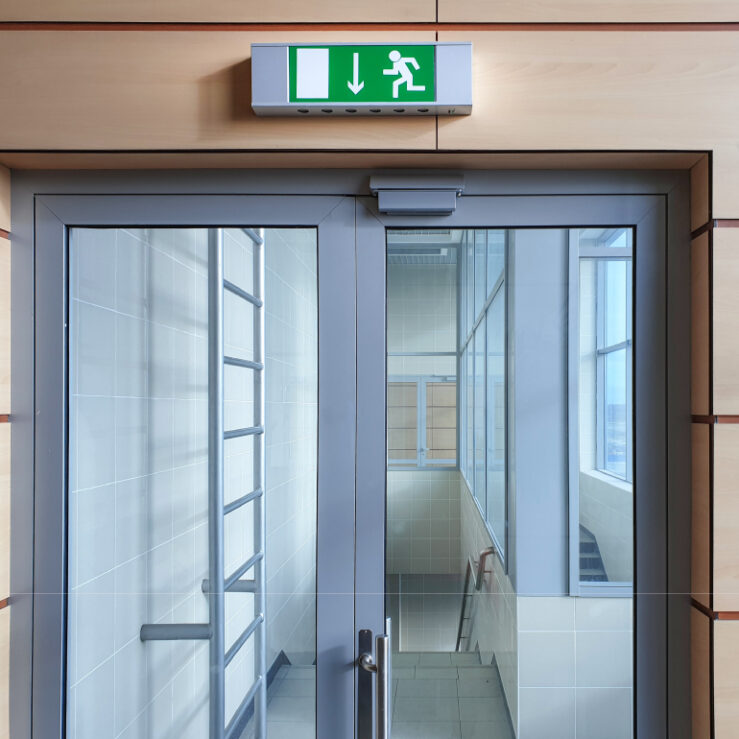Fire doors are one of the most critical components in any building’s fire strategy. They help protect escape routes, maintain compartmentation, and contain fire and smoke long enough for people to evacuate safely. So, when the testing standards behind those doors begin to change, it’s natural for building owners, duty holders and responsible persons to have questions.
The UK is gradually moving from the long-standing BS 476-22 fire-door test to a European-based system of BS EN 13501-2, supported by EN 1634-1, September 2029. While this shift has raised concerns, industry bodies are clear: there is no need to panic. What matters is understanding what’s changing, what isn’t, and how to manage the transition confidently.
At Commercial Fire Protection, our role is to help you do exactly that.
Why is the standard changing?
BS 476-22 has been in place for decades and has supported the safe installation of many thousands of fire doors, and the move to the European classification system isn’t because BS-tested doors are unsafe.
Instead, in the wake of the Hackitt Review and wider construction-product reform, the government has been steering the industry toward clearer, more consistent and more traceable test data. The European classification route (BS EN 13501-2) supports this by offering:
- A single, structured classification system
- Test methods aligned with modern building practices
- Greater international consistency
- Clearer and more traceable performance data
The goal is better alignment and long-term reliability, not the rejection of existing standards.
What is changing and when?
The transition is gradual. BS 476 remains recognised in Approved Document B until September 2029. After that, new fire doors will need to be classified under the EN system.
Key changes include:
- New classifications (e.g., EI30/EI60 rather than FD30/FD60)
- Updated test methods and measurement procedures
- More standardised evidence of performance that supports wider product-safety reforms
Despite these differences, the purpose remains the same: ensuring fire doors perform when needed.
Do existing BS-tested fire doors need to be replaced?
No. Existing doors tested to BS 476-22 remain valid and compliant as long as they:
- Are correctly installed
- Are matched with the right frames and hardware
- Are properly maintained
- Have supporting documentation where required
There is no requirement to remove or replace compliant BS-tested doors solely because of the change in testing standard and the standard remains recognised until 2029.
In fact, for most buildings, the greatest risk is not the test standard itself – it’s poor installation, missing evidence, hardware that doesn’t match the certificate, or inadequate maintenance. These are the issues that compromise fire doors every day, regardless of which standard they were tested to.
What does this mean for building owners and duty holders?
Your responsibilities remain unchanged under the Regulatory Reform (Fire Safety) Order 2005. You must continue to:
- Maintain all fire doors in good working order
- Ensure doors match their certification
- Carry out regular inspections
- Maintain accurate documentation
- Ensure layout changes do not undermine compartmentation or fire strategy
What will evolve is the specification of new fire doors, as manufacturers transition to EN-classified products.
Your priority should be understanding your current stock and planning sensibly for future replacements rather than rushing into unnecessary upgrades.
How Commercial Fire Protection supports a smooth transition
At CFP, we’re already aligned with the new testing landscape. We’re here to help clients move through the transition calmly, confidently and without disruption.
- Fire Door Audits
We review every fire door on-site, checking installation quality, certification, hardware compatibility and general condition.
We also consider how doors interact with your building’s compartmentation and fire strategy, ensuring each one performs within the wider passive fire protection system.
- Ongoing Maintenance & Inspections
Regular inspection is still the single most important factor in ensuring door performance – whether classified under BS 476 or the new EN system, a poorly maintained door will fail when it counts.
At CFP, we provide routine fire door inspections and remedial works.
through our service agreements.
- Future-proofed specification
For refurbishments or new installations, we specify and install doors meeting the new EN classifications, ensuring long-term compliance and clear traceability.
- Clear planning and phased upgrades
If parts of your building will eventually require upgrades, we help you:
- Prioritise doors based on risk
- Spread costs over sensible timelines
- Avoid replacing compliant doors unnecessarily
- Training, documentation & support
We help your teams understand the changes, identify compliant doors, and set up clear door registers with full evidence trails to support future audits or regulatory checks.
A practical change, not a crisis
The shift from British Standard to European Standard testing is an evolution, not a disruption. It strengthens transparency, improves consistency and supports the wider cultural shift toward safer, better-evidenced building products.
At Commercial Fire Protection, our job is to make sure you navigate that change without stress, confusion or unnecessary cost. Whether you manage a single building or a national portfolio, we help you remain compliant today and ready for tomorrow.
If you’d like support understanding your fire-door stock, planning upgrades or reviewing compliance, talk to us today – we are here to help.




